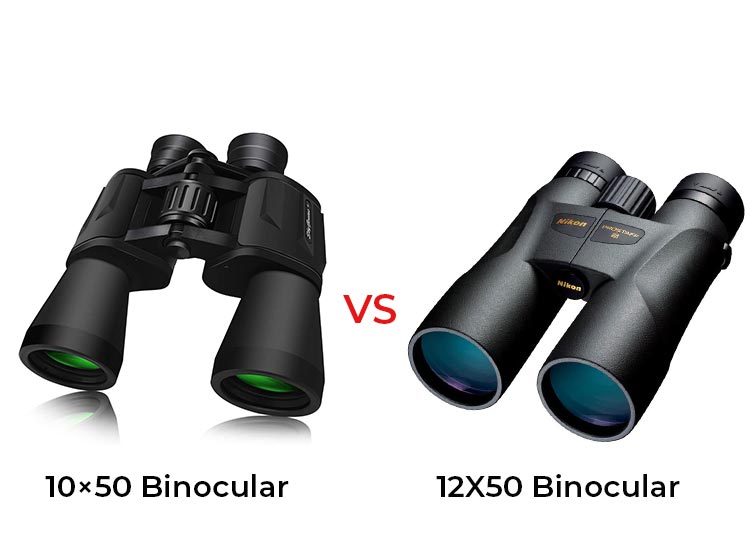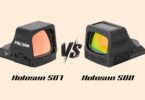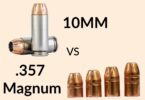There isn’t a big difference between 10×50 and 12×50 binoculars but the minute details may have an impact on your viewing experience.
Here we will see how exactly they differ so you can easily find your best match.
10×50 vs 12×50 Binoculars: How Do They Differ?

Magnification power vs stability
- 10×50
10×50 brings images 10 times closer than what you see with naked eyes. This facilitates a wider field of view compared to binoculars with higher magnification levels. The lower magnification is needed in situations where you need a quick focus on the go.
- 12×50
The 12 times magnification of these models is amazing for long-distance viewing but you’ll find it hard to observe things for a longer period. They may also make your hands shaky unless you lean against a firm object or use a tripod.
- Winner
12×50 pairs win this round with their higher magnifications but the 10x50s offer more stability.
Weight of 12×50 vs 10×50 Binoculars
- 10×50
The weight difference is really insignificant here.
10×50 binos may weigh 2.25 lbs while the 12×50 variants are around 2.3 lbs.
- 12×50
They may not weigh much but you need a tripod for steadiness, which may increase the overall mass.
- Winner
Nobody wins here since there is no significant difference in their weight.
Using with tripod vs freehand
- 10×50
10×50 binos allow you to have fast hand-held sessions more readily than 12x50s. They are a good quick “grab and go” option for imaging.
- 12×50
12×50 pairs are great to use on a chair with your head and elbows supported but you will have a hard time when going freehanded and flatfooted.
Even if you prefer a p-mount or monopod, setting them up will take longer and you’ll have restricted movements.
- Winner
10x50s are the better choice when you want to use your binoculars freehanded.
Exit pupil
- 10×50
The exit pupil of 10×50 binoculars is bigger than that of 12x50s (5 mm vs 4.16 mm). The bigger exit pupils work fine when it’s dark outside.
Your pupil dilates about 7 mm in such situations, so you need the larger lenses for an enhanced and optimal view.
- 12×50
12x50s with their 4.16 mm exit pupil are not strictly low light performers but more like all-rounders. This hybrid configuration allows you to have both long-distance viewing and good visibility in dark environments at the same time.
- Winner
10×50 binoculars are the winner since their larger exit pupils work better in low-light conditions.
Eye relief
- 10×50
Eye relief differs between models and sizes but 10x50s tend to have a longer eye relief. The recommended eye relief length for binoculars is at least 15 mm while 10×50 models have 16 mm or more.
You also have the option to use the retractable eyecup on the device for some space between your eye and the ocular lens. Keeping this distance will help prevent the appearance of a vignetting from getting in the shape of a crescent shadow and shifting around the field of view when your eyes dart around.
You will see a black ring appearing around the circumference if you keep your eyes too far away from the ocular lenses.
- 12×50
The eye relief is 15 mm or less, so you may see a black ring appearing around the circumference even with the eyecups down.
- Winner
10×50 binoculars have more eye relief so they win this round.
Performance under light-polluted skies
- 10×50
These devices perform well when you have access to better quality skies.
- 12×50
The higher zoom makes 12x50s ideal to see the sky in light-polluted places.
- Winner
Pick 12×50 binoculars if you live in polluted areas for a clearer picture.
Comfortability
- 10×50
10x50s are versatile, comfortable to use, and offer a relaxed view. You’re sure to have a good observing experience that you want.
- 12×50
You’ll feel the weight when you hold the device with your hands or hang it around your neck but they are still comfortable to use and not overly heavy.
- Winner
Both types are comfortable to use in hand, so it’s a tie.
Short period vs long period use
- 10×50
10x50s have less handshaking with a longer time of use, so you won’t have a problem looking at the sky for hours.
- 12×50
The extra weight of 12x50s makes it hard to observe for long. You need to lean against a tree or stone for long periods of use.
- Winner
10x50s allow for a more hassle-free long-time user experience.
Field of view
- 10×50
The field of view of 10×50 binoculars is wider compared to 12x50s. The wider FOV allows you to find your hunt easily when glassing shorter distances.
- 12×50
12x50s give you a narrower FOV but higher magnification, which is ideal to find game from long distances in plain areas.
- Winner
The wider FOV makes the 10×50 the obvious winner.
Price
- 10×50
The price range between 10×50 and 12×50 binoculars doesn’t differ much but the 10×50 models cost slightly lesser.
- 12×50
12x50s cost slightly more for their higher magnification setup.
- Winner
The 10×50 suits the budget-conscious users more.
10×50 vs 12×50 Binoculars: What’s Best For You?
Go for the 10×50 if you are a beginner, like to use them freehanded, or prefer a wider field of view.
12x50s are your best pick when you need to see a light-polluted sky. They’re also great for bird watching, hiking, traveling, and observing wildlife. Just set your pair on a tripod or a p-mount so you have a clear view of the stars for hours.








Leave a Comment